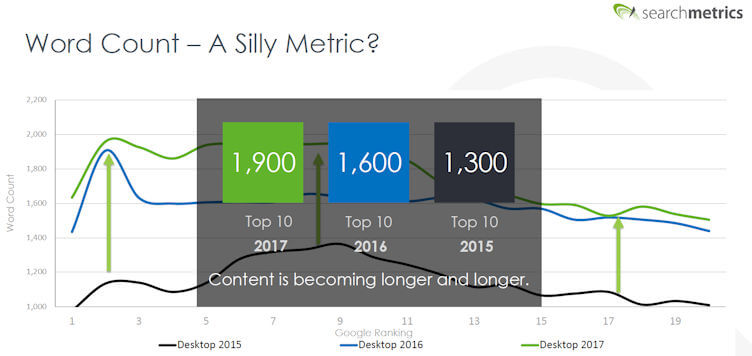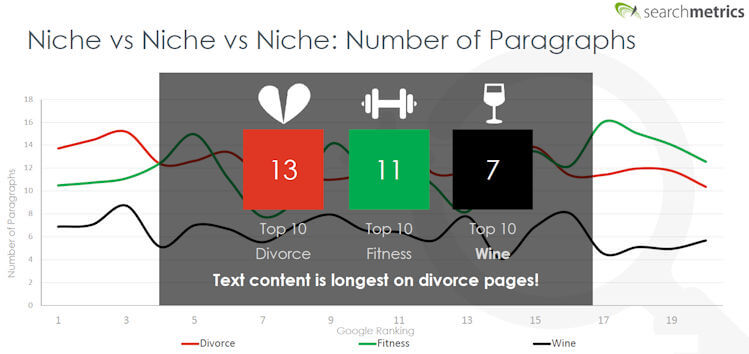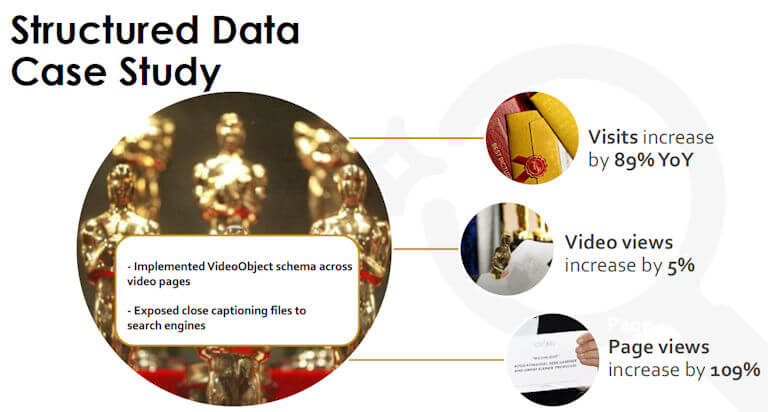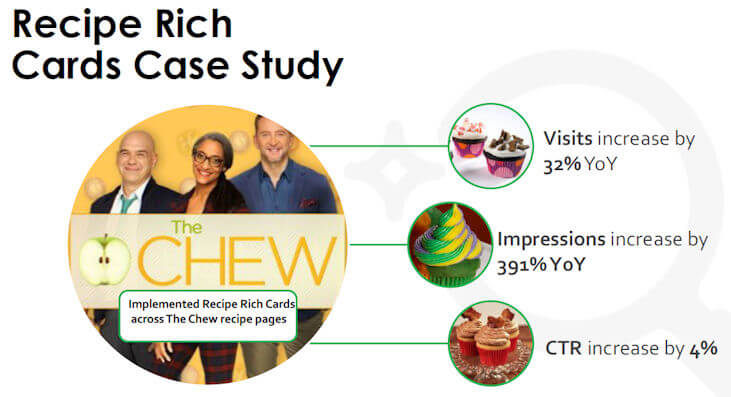 I attended the SEO Ranking Factors session at this year’s SMX West and enjoyed listening to the panelists present their opinions, experiences and ideas.
I attended the SEO Ranking Factors session at this year’s SMX West and enjoyed listening to the panelists present their opinions, experiences and ideas.

Any discussion of ranking factors raises a lot of emotions and controversy, and this was no exception. It is important to understand how to use information from these types of sessions: None of the data is fully conclusive, and it should always be taken with a grain of salt.
What it does tell us is the types of things that matter in the market, not what factors directly drive rankings.
That said, our panelists shared some great insights, so let’s dig in!
Olga Andrienko of SEMrush
Olga was the first to present. She covered her company’s recent ranking factors study where they looked at the top 100 positions across 600,000 keywords and segregated those keywords by competitiveness.
Unlike other ranking factors studies that rely on traditional correlation measurements (e.g., Pearson or Spearman correlation measurements), SEMrush used a machine learning model called Random Forest.
This is a model based on random dataset sampling to build decision trees. The approach involves taking several different data samples, building models with that data and then averaging the results across all the samples.
This approach can result in much better fits to the data in the training set but does carry with it some risk of “overfitting” the data. The study looked at several on-page factors like links and traffic.
I’m going to pull the points from Olga’s talk I found most interesting.
The first observation I’ll highlight from the study relates to the use of keywords in the title tag. Here is the slide from her deck:

As you can see, the study reports the keyword in the title in only 35 percent of the pages they studied.
The chart also shows the percentage is far higher for the most competitive keywords. Notice the yellow dotted link is over 60 percent!
This follows what intuition would tell us: Keywords in the title matter more for competitive terms.
Keep in mind this relates to using the exact keyword phrase in the title. Titles that use related words, or uses all the words in a different order, will not show as a match.
The next point I found interesting relates to how keyword-rich anchor text is used. Here is the slide:

The big point that emerges from this slide is how infrequently keyword phrases are being used in content that ranks well, even for high-volume terms. There is some great good news in this: It suggests link spamming on the web is down. As an industry, we should celebrate that. It also suggests ranking highly can be done without getting a lot of rich anchor text links to your page.
However, you can also infer getting keyword-rich anchor text to your page can help if you’re trying to get to the number one spot. Just don’t use that suggestion as a motivator to start a spammy link campaign!
Content length is another issue the study addressed, as shown here:

In spite of all the discussion around making content shorter for mobile, this data suggests longer content length helps with ranking. The study shows the top three ranking positions host longer content.
In spite of all the things we hear about people wanting short, quick reading content, it doesn’t seem that’s really the case.
The SEMrush study also addressed the topic of page speed, finding higher-ranking pages across all the keywords groups loaded significantly faster than the lower-ranking pages.
I found the chart on “time to first meaningful paint” particularly interesting:

First Meaningful Paint measures the time it takes for primary webpage content to first appear on a users screen. See how the data shows the ranking curve favoring faster sites? The chart for time to first meaningful activity showed a similar result.
This data does not mean speed is a direct ranking factor, but other studies have shown people like faster-loading sites.
Last but not least, I found the slide on links quite interesting:

The data supports the notion links still matter a great deal in terms of determining where a webpage ranks.
We also see the number two position has quite a large peak of links across all keyword groups. I’m still trying to decipher that one.
Here is Olga Andrienko’s presentation:
Marcus Tober of Searchmetrics
Marcus focused on two themes:
- The idea that ranking studies are harmful to the search industry.
- The importance of performing ranking analyses on an industry-by-industry basis.
For the first point, I think it’s safe to say, a ranking study can do harm if you apply or believe the implications blindly.
Just because higher-ranking pages are faster, it doesn’t mean they drive ranking. But it could be a strong indicator that having faster pages is important to ranking well.
One of the points he used to illustrate this was content length. Just like the SEMrush study, Marcus reported longer content appears to rank better.
In fact, the length of content in the top 10 of the search engine ranking pages (SERPs) appears to be going up over time:

During much of his presentation, Marcus reviewed how different market sectors vary. The sectors he looked at were dating, wine, recipes, furniture, car tuning and divorce.
For his second point (the importance of performing ranking analyses on an industry-by-industry basis), Marcus explored the role of microdata and using it to compare dating, recipes and divorce segments:

The recipes segment has the highest usage of microdata by far. That is not surprising since Google lets you mark up recipe content with structured data, which, in turn, provides rich results and increased search visibility.
Another one of Marcus’s points focused on video:

I really like this point because it shows how you need to tailor your content based on the market you’re in.
If you’re in the fitness business, videos make a lot of sense, but not so much for divorce or wine.
This highlights how studies may not always be focused on ranking factors but still share insights which offer value.
Another interesting observation Marcus shared was about content length across the divorce, fitness and furniture markets:

Notice how content on divorce sites tends to be longer, while fitness is far behind. This shows that the need for longer content varies by market.
People looking for wine don’t want to read, they want to drink!
In contrast, though, when it comes to images, Marcus compares the divorce, recipes and furniture markets:

See how the furniture market is the clear leader here, which makes sense. When you’re selling furniture, you need to create a visual experience with lots of choices.
For recipes, visuals are important, as people want to see what the food will look like. But in the divorce market, images are not nearly as useful.
Here is Marcus Tober’s presentation:
Chanelle Harbin, Disney/ABC Television Group
Last, but not least, was Chanelle Harbin who shared a series of real-world case studies.
The first case study related to structured data. In this case study, Chanelle and her team implemented VideoObject schema across video pages. They also exposed closed captioning to the search engines, with these results:

The scale of growth of visits and page views is impressive! This is also consistent with what I have seen across other schema.org tests that I’ve participated in.
The American Broadcasting Company (ABC) also measured the results when they implemented structured data cross recipe pages for the television show “The Chew.” The results here were also spectacular:

I am a strong proponent of the value of featured snippets. Chanelle shared some great data from what they saw when they obtained a featured snippet for the phrase “Beyoncé guacamole recipe”:

Now, that’s a serious uptick in traffic!
ABC also participated in some good old-fashioned link building. Here are some of the key actions they took:
- Reached out to sites mentioning shows and requesting those mentions get converted to links.
- Noticed broken links intended to target key pages and then asked those people to fix the links.
- Contacted sites that had very similar content that ranked highly.
These are all very basic practices that any site can take on, and the results that ABC got were stellar. Here are a couple of examples:

Last, but not least ABC ran tests to compare the performance of non-AMP pages with accelerated mobile pages (AMP). Here are the user engagement results they saw from these tests:

Here are the improvements in traffic:

Bear in mind that AMP is not a ranking factor, but as ABC is a news site, participation in AMP made them eligible for the AMP news carousel on smartphone devices.
It’s been suggested that Google may let non-AMP pages appear in the smartphone news carousel and Top Stories on desktop in the future. Even if that does happen, the user engagement benefits ABC received will remain in place.
Here is Chanelle Harbin’s full presentation:
Summary
This was a great session. Keep in mind not everything shared is a ranking factor, but it’s all good information you can use for your website and business.
The post SEO Ranking factors panel: SMX West session recap appeared first on Search Engine Land.
No comments:
Post a Comment